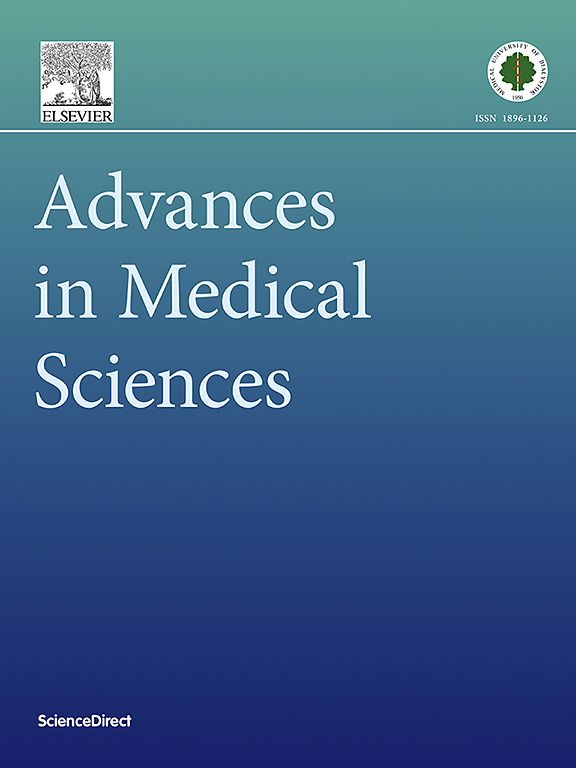Prevalence of hepatitis D virus in chronic hepatitis B patients: findings from Poland
IF 2.6
4区 医学
Q3 MEDICINE, RESEARCH & EXPERIMENTAL
引用次数: 0
Abstract
Purpose
This study aimed to determine the prevalence of hepatitis B/hepatitis D virus (HBV/HDV) co-infections in eastern Poland.
Materials/methods
We included consecutive patients with chronic hepatitis B treated with nucleos(t)ide analogues (NA) in the study, in whom we performed anti-HDV assays verified by molecular testing.
Results
The analysed population consisted of 398 patients, predominantly male with a median age of 50 years, 58.3 % of whom had comorbidities. Forty-three patients (10.8 %) were diagnosed with cirrhosis. Patients were treated with entecavir, tenofovir, or lamivudine for a median of 5 years. At the start of treatment, the median viral load was 5110 IU/ml, and 98 % of patients achieved viral eradication during the therapy. In the study population, anti-HDV antibodies were detected in 6 patients (1.5 %), 3 men and 3 women, of whom in 1 (0.25 %) the presence of genetic material of the HDV was confirmed by molecular testing.
Among anti-HDV-positive patients, 3 (50 %) had cirrhosis, 1 of them underwent liver transplantation, and 2 had extrahepatic malignancy. All of them were negative for hepatitis B virus envelope (HBe) antigen and had antibodies to HBe antigen present at the beginning of antiviral treatment. All anti-HDV-positive patients achieved viral clearance during the therapy.
Conclusion
In a population of almost four hundred patients infected with HBV, we observed a low prevalence of anti-HDV antibodies of 1.5 % and HDV replication of only 0.25 %. Half of the 6 patients with serologic evidence of co-infection had cirrhosis, so HDV likely played a role in disease progression.
慢性乙型肝炎患者中丁型肝炎病毒的流行:来自波兰的调查结果
目的:本研究旨在确定波兰东部乙型肝炎/丁型肝炎病毒(HBV/HDV)合并感染的患病率。材料/方法我们在研究中纳入了连续接受核苷类似物(NA)治疗的慢性乙型肝炎患者,我们对他们进行了抗hdv检测,并通过分子检测进行了验证。结果分析人群包括398例患者,以男性为主,中位年龄50岁,58.3%的患者有合并症。43例(10.8%)被诊断为肝硬化。患者接受恩替卡韦、替诺福韦或拉米夫定治疗的中位时间为5年。在治疗开始时,中位病毒载量为5110 IU/ml, 98%的患者在治疗期间实现了病毒根除。在研究人群中,6名患者(1.5%)检测到抗HDV抗体,其中3名男性和3名女性,其中1名(0.25%)通过分子检测证实存在HDV遗传物质。抗hiv阳性患者中,肝硬化3例(50%),肝移植1例,肝外恶性肿瘤2例。所有患者乙型肝炎病毒包膜(HBe)抗原呈阴性,抗病毒治疗开始时均有HBe抗原抗体。在治疗期间,所有抗hiv阳性患者都实现了病毒清除。结论在近400名感染HBV的患者中,我们观察到抗HDV抗体的低患病率为1.5%,HDV复制率仅为0.25%。有血清学证据的6例合并感染患者中有一半患有肝硬化,因此HDV可能在疾病进展中起作用。
本文章由计算机程序翻译,如有差异,请以英文原文为准。
求助全文
约1分钟内获得全文
求助全文
来源期刊

Advances in medical sciences
医学-医学:研究与实验
CiteScore
5.00
自引率
0.00%
发文量
53
审稿时长
25 days
期刊介绍:
Advances in Medical Sciences is an international, peer-reviewed journal that welcomes original research articles and reviews on current advances in life sciences, preclinical and clinical medicine, and related disciplines.
The Journal’s primary aim is to make every effort to contribute to progress in medical sciences. The strive is to bridge laboratory and clinical settings with cutting edge research findings and new developments.
Advances in Medical Sciences publishes articles which bring novel insights into diagnostic and molecular imaging, offering essential prior knowledge for diagnosis and treatment indispensable in all areas of medical sciences. It also publishes articles on pathological sciences giving foundation knowledge on the overall study of human diseases. Through its publications Advances in Medical Sciences also stresses the importance of pharmaceutical sciences as a rapidly and ever expanding area of research on drug design, development, action and evaluation contributing significantly to a variety of scientific disciplines.
The journal welcomes submissions from the following disciplines:
General and internal medicine,
Cancer research,
Genetics,
Endocrinology,
Gastroenterology,
Cardiology and Cardiovascular Medicine,
Immunology and Allergy,
Pathology and Forensic Medicine,
Cell and molecular Biology,
Haematology,
Biochemistry,
Clinical and Experimental Pathology.
 求助内容:
求助内容: 应助结果提醒方式:
应助结果提醒方式:


